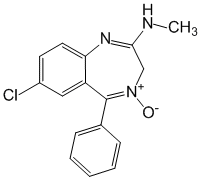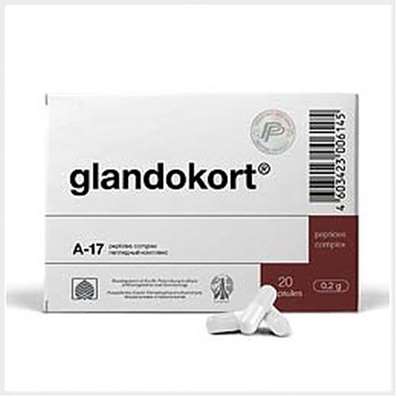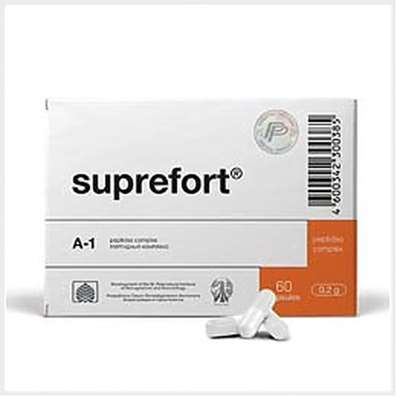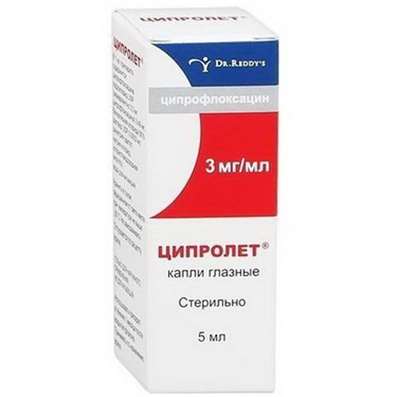Chlordiazepoxide - Active Substances. Instruction and Application, Dosage
26 Dec 2016
Name: Chlordiazepoxide
The Latin name of the substance Chlordiazepoxide
Chlordiazepoxydum (genus Chlordiazepoxydi)
Chemical name: 7-Chloro-N-methyl-5-phenyl-3H-1,4-benzodiazepin-2-amino-4-oxide (as hydrochloride)
Formula - C16H14ClN3O

Therapeutic substances Chlordiazepoxide - anxiolytics
The nosological classification (ICD-10)
F07 Personality disorders and behavior caused by disease, injury, or dysfunction of the brain
F10.3 abstinence
F10.4 abstinent state with delirium
F10.5Alcoholic psychosis
F11 Mental and behavioral disorders due to use of opioids
F20 Schizophrenia
F32 Depressive episode
F40.0 Agoraphobia
F41.1 Generalized anxiety disorder
F42 Obsessive-compulsive disorder
F44 Dissociative [conversion] disorders
F45 Somatoform disorders
F51.0 Insomnia inorganic etiology
G44.2 tension headache types
G47.0 Disorders of falling asleep and maintaining sleep [insomnia]
G56.4 causalgia
L29 Itching
N50.8.0 * Menopause in men
N94.3 syndrome premenstrual tension
N95.1 menopausal and menopausal status of women
R06.6 Hiccups
R07.2 Pain in the heart
R25.2 Cramp and spasm
R25.8.0 * hyperkinesia
R45.1 Restlessness and agitation
R45.4 Irritability and anger
Z100 * CLASS XXII Surgical practice
Z54.0 recovery period after surgery
CAS code - 58-25-3
Characteristics substance Chlordiazepoxide
Anxiolytic, benzodiazepine derivative.
White or light yellow crystalline powder. Practically insoluble in water, it is soluble in alcohol; as the hydrochloride - is soluble in water.
PharmacologyMode of action - anxiolytic, sedative, hypnotic, muscle relaxant, central.
Interacts with specific benzodiazepine receptors located in postsynaptic GABAA receptor complex in the cerebral cortex, amygdala, hippocampus, hypothalamus, cerebellum, striatum, and spinal cord. Increases the sensitivity of neuronal GABA receptors to GABA enhances GABA neurotransmission, blocks polysinaptic reflexes.
After oral administration, it is well absorbed from the gastrointestinal tract (food slows absorption); Cmax when administered single dose reached after 0.5-4 hours and the equilibrium concentration in the blood is 5-12 days after the beginning of reception. Plasma protein binding is 96%. T1 / 2 chlordiazepoxide from plasma is 7-28 hours, the Cmax of the main metabolite (desmethyl-chlordiazepoxide.) - 8-24 hours The liver is intensive metabolism (N-demethylation, deamination, hydroxylation) to form active derivatives (desmethyl-chlordiazepoxide, demoksepam , desmethyl-diazepam, oxazepam). It passes through GEB, placenta, enters the breast milk; slowly absorbed from the muscle tissue. After the treatment, the metabolites found in the plasma for a few days or even weeks. T1 / 2 - 5-30 hours (chlordiazepoxide), 18 hours (desmethyl-chlordiazepoxide), 14-95 hours (demoksepam), 30-100 hours (dezmetildiazepam), 5-15 hours (oxazepam). Report mostly kidneys (1-2% unchanged). Accumulation of chlordiazepoxide and its active metabolites with repeated use significantly.
Older people chlordiazepoxide absorption and metabolism are slower, significantly slowing down the metabolic transformation at the defeat of the liver.
It has a marked sedative effect on the central nervous system. It suppresses the alarm, excitement, emotional stress. Weakens the obsessions and fears, increases susceptibility to hypnosuggestive therapy. Has anti-panic effect, it relieves tremors, has a weak anticonvulsant effect. It reduces the severity of anxiety and fear associated with the upcoming surgery.
In large doses, can reduce agitation. Exhibits mild hypnotic effect which is expressed usually in the first 3-5 days of treatment, further positive effects on sleep due to the elimination of various psychogenic stimuli. It causes moderate muscle relaxation.
Relieves the symptoms of acute alcohol withdrawal symptoms such as agitation, nervousness, anxiety, anxiety, tremors, and others. Increases appetite, it has a weak analgesic effect.
Reproduction studies in animals showed that the introduction of chlordiazepoxide in rats at doses of 10, 20 and 80 mg / kg / day did not cause of congenital malformations and disorders of neonatal growth, as well as violation of lactation in females. In another study, when administered dose of 100 mg / kg / day a significant reduction in the fertilization rate was revealed marked reduction of body weight and survival in neonatal rats.
Application of the substance Chlordiazepoxide
Neurotic state accompanied by anxiety, agitation, increased irritability, emotional stress, insomnia; neurotic ataxia, tension headache, false angina, esophageal spasm, causalgia, facial gemispazm, hysterical state (hysterics, amblyopia, mutism, paralysis), psychogenic stupor, hiccups; nevrozo- and psychopathic disorders in patients with cerebral atherosclerosis, organic brain damage; infectious delirium, withdrawal syndrome in patients with alcoholism and drug addiction; increased skeletal muscle tone, hyperkinesia rheumatic and neurotic; menopause, premenstrual syndrome, vascular dystonia; premedication (preparation of patients for operations and lengthy diagnostic procedures), the postoperative period; complex therapy in schizophrenia with symptoms of neurosis, as well as in diseases accompanied by itching, irritability, insomnia, including eczema.
Contraindications
Hypersensitivity, severe myasthenia gravis, respiratory depression, angle-closure glaucoma, acute liver disease and / or kidney disease, pregnancy (I term), breast-feeding, age up to 4 years.
Restrictions of application of Chlordiazepoxide
Glaucoma, liver and / or kidney problems, sleep apnea syndrome, severe heart and respiratory failure, ataxia (except neurotic), psychosis (possible paradoxical increase in symptoms), drug or alcohol dependence (except for the treatment of acute withdrawal syndrome), pregnancy ( II and III trimester), advanced age.
Pregnancy and breast-feeding
It contraindicated in I trimester of pregnancy (increases the risk of congenital malformations when administered during this period). In II and III trimester of pregnancy is possible if the expected effect of therapy outweighs the potential risk to the fetus. At the time of treatment should stop breastfeeding.
Side effects of Chlordiazepoxide substance
From the nervous system and sensory organs: drowsiness, fatigue, impaired memory and concentration, mental retardation and motor reactions, muscle weakness, gait disturbance, ataxia, confusion, disorientation, dizziness, headache, EEG changes.
Cardio-vascular system and blood (blood, hemostasis): tachycardia, palpitations, hypotension (at high doses), thrombocytopenia, agranulocytosis.
From the digestive tract: dry mouth, nausea, constipation or diarrhea, intestinal colic, abnormal liver function, jaundice of the skin.
Allergic reactions: skin rash, itching, peeling skin.
Other: difficulty breathing, urinary retention, menstrual disorders, libido change (increase or decrease).
Possible addiction, drug dependence, withdrawal syndrome and others.
Interaction
Enhances the effects of alcohol and CNS depressants (opioids, anesthetic, hypnotics, antipsychotics with sedating effect), muscle relaxants, and others. Antacids delay absorption (but do not reduce the extent of absorption) chlordiazepoxide. Chlordiazepoxide may weaken the effect of levodopa. Cimetidine, estrogen oral contraceptives, disulfiram and erythromycin chlordiazepoxide slow metabolism in the liver, increase in blood concentration and delayed excretion. Smoking can weaken the effect of chlordiazepoxide.
Overdose of Chlordiazepoxide
Symptoms: oppression CNS varying degrees of symptoms (from somnolence to coma) - marked drowsiness, lethargy, weakness, loss of muscle tone, long-term mental confusion, disorientation, slurred speech, depression of reflexes, coma; also possible respiratory depression, hypotension.
Treatment: induction vomiting, immediate gastric lavage, monitoring of vital functions, symptomatic therapy, in / in infusion solutions (to increase urine output), the provision of adequate ventilation; in the case of hypotension - introduction of norepinephrine. When driving the development should not be used barbiturates. As a specific antidote used BZ antagonist flumazenil receptors (in the hospital). Hemodialysis is ineffective.
Dosing and Administration of Chlordiazepoxide
Inside. Doses (single and daily) and duration of treatment are selected strictly individually, depending on the nature and course of the disease, tolerance and others. Treatment should be started with the lowest effective dose corresponding to a particular form of pathology.
The usual single dose for adults - 5-10 mg, the usual daily - 20-60 mg (2-4 doses). When the state of stress in combination with sleep disorders - 10-20 mg 1 time per day for 1-2 hours before bedtime. In psychiatry - 50-100 mg / day, with alcohol withdrawal syndrome - 300 mg / day in 3-4 divided doses.
Patients are elderly, debilitated patients, patients with diseases of the liver and / or kidney disease should be prescribed lower doses (single - 2.5-5 mg). The treatment duration should not exceed 2.5 months. A second course (if necessary) - no earlier than 3 weeks.
Children starting at age 4 years dose (and duration of treatment) are selected individually depending on the age, body weight and others.
Precautions substance Chlordiazepoxide
Note that the combination of anxiety with depression may attempt suicide.
To apply caution in conjunction with other psychotropic drugs. Should not be administered concurrently with MAO inhibitors and phenothiazines.
With prolonged use (over several months), particularly at high doses, may addiction, drug dependence. Abolition of chlordiazepoxide should be done gradually by reducing the dose to reduce the risk of withdrawal syndrome characterized by tremor, cramps, abdominal and muscle cramps, vomiting, sweating. In abrupt cancellation also possible agitation, anxiety, autonomic disorders, insomnia.
Do not take chlordiazepoxide more than 4 weeks without re-evaluation of the patient to decide whether to continue therapy.
The probability of side effects is higher in the elderly.
Prolonged use should be periodically monitored picture peripheral blood and liver function.
There are reports that in the treatment of chlordiazepoxide mental patients and children with the aggressive behavior traits observed paradoxical reactions (psychomotor agitation, rage, etc.).. In the case of paradoxical reactions, treatment should be discontinued immediately.
It should be borne in mind that chlordiazepoxide can reduce mental alertness in children.
It must be borne in mind that there are reports of effects on blood coagulation in patients taking oral anticoagulants simultaneously and chlordiazepoxide (in a clinical study of the causes and consequences of this interaction has not been established). There are some reports of exacerbation of porphyria under the action of chlordiazepoxide. Hypoproteinemia may predispose to increase the frequency of sedative side effects.
During treatment and for 3 days after its cancellation should be deleted reception alcohol; drivers of vehicles and people whose work requires quick mental and physical reactions, and is also associated with high concentration of attention, should not engage in professional activities during this period.
Special instructions for Chlordiazepoxide
Keep in mind that anxiety or tension associated with everyday stress usually does not require treatment with an anxiolytic.
Trading names of drugs with Chlordiazepoxide working substance
Trade Name Index
Napoton, Radepur 10, Hlozepida coated tablets, 0.005 g, Elenium

 Cart
Cart





